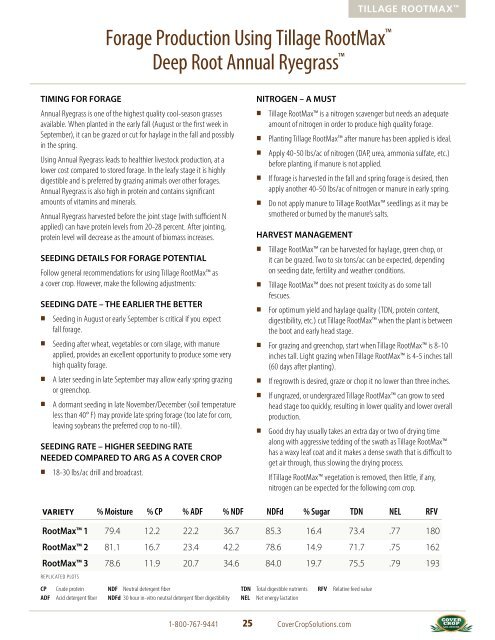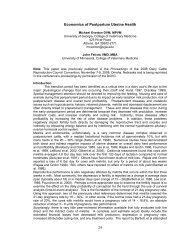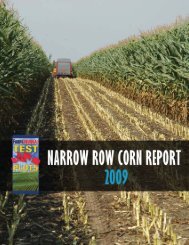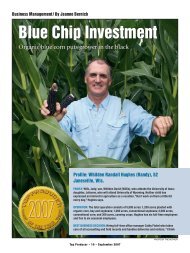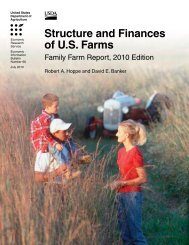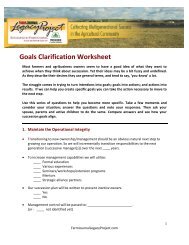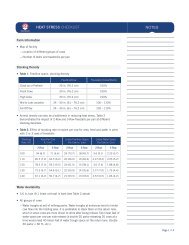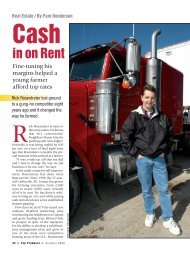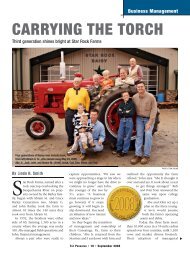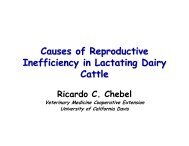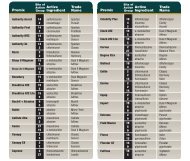Burndown & Control of <strong>Tillage</strong> RootMax Deep Root Annual Ryegrass Following these management steps will help increase successful burndown and control of <strong>Tillage</strong> RootMax Deep Root Annual Ryegrass.TIP If this is your first time managing annual ryegrass, for peace of mind it can be helpful to take photos each day for a week to document the burndown.TILLAGE ROOTMAX THE PLANT• Control Annual Ryegrass before the first node appears when possible.First node / jointControl is most effective before the first node/joint appears. Once the third node/jointappears control is poor because of limitedtranslocation, because active growth in theplant goes to reproduction.Uncertified Annual Ryegrass seed may growat different rates, making control more difficultbecause of uneven maturity. Certified seedgrows at a uniform rate, which makes controlUNCERTIFIED CERTIFIED with a single application easier to achieve.THE CHEMISTRY• Remove all traces of atrazine or mesotrione (Calisto,* Lumax, Lexar)in the spray tank when using glyphosate.• Glyphosate recommendations are now 2 qts per acre.• Inconsistent control has been experienced using Accent (nicosulfuron)or Steadfast post emergence on corn. Follow the label even withadding fertilizer, AMS and crop oil to improve herbicide absorptionefficiency.• Glyphosate works effectively alone or with 2,4-D. MAINTAIN the 2 qt.rate of glyphosate IF adding Princep, Balance Pro (isoxaflutole), ProwlH2O (pendimethalin), Resolve (rimsulfuron), Basis (rimsulfuron &thifensulfuron), Corvus (Thiencarbazone-methyl & Isoxaflutole) orAxiom (fluefenecet + metribuzin) to the glyphosate application.TECHNIQUE• Make sure the spray tank water is between 4.5 to 5.5 pH. Make sure toadd AMS (ammonium sulfate) or citric acid, with 3-5 minutes ofagitation for pH adjustment. This step is critical when water is high incalcium, magnesium, iron and other minerals that interfere withglyphosate activity. Agitation of the mixture is cheap insurance.• Don’t pull your punches. Use the full strength of the suggested controlrate. The goal is complete control on the first pass.• If you use a generic brand of control, make sure to adjust the rate.• Plant contact is critical. Use a medium spray droplet size or moderatespray pressure. Spray application volume should be 8 to 12 gallons peracre, so spray strength is important.SOURCES: Annual Ryegrass <strong>Cover</strong> <strong>Crop</strong> Management for Corn and Soybean Production 2012; management recommendationsby Mike Plumer, <strong>Cover</strong> <strong>Crop</strong> Specialist; Mark Melbye, OSU Ext. Agronomist; Andy Hulting, OSU Ext. Weed Management Specialist* Herbicide brands mentioned here are recognized as the property of their respective manufacturers.1-800-767-9441 <strong>Cover</strong><strong>Crop</strong><strong>Solutions</strong>.comTIMING• Warm temperatures are essential to translocate glyphosatethroughout the plant so that it is absorbed into the roots for control.CONTROL IS BEST WHEN THE PLANT IS ACTIVELYGROWING (HIGH TRANSLOCATION)Key trigger points to consider when controlling with glyphosate.1. Top Growth should be more than 7 inches2. Sunlight – the more the better3. Soil Temperatures – above 45 degrees F4. Air Temperatures – above 60 degrees F5. Moisture – growing conditions should be goodIf night temperatures go below 38 degrees wait 3 days before spraying.This is due to a protection mechanism by the plant to prevent freezingtissue.• Spray at least 4-5 hours prior to sunset to allow translocation time.• If a second pass is needed, there should be a minimum of three weeksafter the first control application. The regrowth and retillering willallow for more herbicide to get to the roots for final control.FOR ROUNDUP READY CORN OR SOYBEANSWhen planting Roundup Ready corn or soybeans after emergence use a fullrate of glyphosate – up to 2 quarts per acre. On Roundup Ready soybeansyou can add SelectMax (clethodim), Poast Plus (sethoxydim) or Fusilade DX(fluazifop), using label instructions on the use of fertilizer, AMS or crop oil.For LIBERTY LINK corn or soybeans after emergenceCORN Liberty does not control annual ryegrass very well. Products withAccent (nicosulfuron) have been inconsistent. Use label recommendationsof adding fertilizer, AMS or crop oil to improve performance.SOYBEANS Add SelectMax (clethodim), Poast Plus (sethoxydim) orFusilade DX (fluazifop), using instructions from the Liberty/Ignite label forany needed additives.FOLLOW THROUGH• Don’t repeat mistakes that may have happened on the first application.• If managing for the first time, take photos on the first day of control,then again every 4-7 days after to see progression as plant goes fromdeep green to brown.• Inspect fields 7-10 days after control application. Be alert for regrowthor missed areas that need further control.• The following year, scout these areas for volunteer ARG.24
Forage Production Using <strong>Tillage</strong> RootMax Deep Root Annual Ryegrass TILLAGE ROOTMAX TIMING FOR FORAGEAnnual Ryegrass is one of the highest quality cool-season grassesavailable. When planted in the early fall (August or the first week inSeptember), it can be grazed or cut for haylage in the fall and possiblyin the spring.Using Annual Ryegrass leads to healthier livestock production, at alower cost compared to stored forage. In the leafy stage it is highlydigestible and is preferred by grazing animals over other forages.Annual Ryegrass is also high in protein and contains significantamounts of vitamins and minerals.Annual Ryegrass harvested before the joint stage (with sufficient Napplied) can have protein levels from 20-28 percent. After jointing,protein level will decrease as the amount of biomass increases.SEEDING DETAILS FOR FORAGE POTENTIALFollow general recommendations for using <strong>Tillage</strong> RootMax asa cover crop. However, make the following adjustments:SEEDING DATE – THE EARLIER THE BETTER• Seeding in August or early September is critical if you expectfall forage.• Seeding after wheat, vegetables or corn silage, with manureapplied, provides an excellent opportunity to produce some veryhigh quality forage.• A later seeding in late September may allow early spring grazingor greenchop.• A dormant seeding in late November/December (soil temperatureless than 40° F) may provide late spring forage (too late for corn,leaving soybeans the preferred crop to no-till).SEEDING RATE – HIGHER SEEDING RATENEEDED COMPARED TO ARG AS A COVER CROP• 18-30 lbs/ac drill and broadcast.NITROGEN – A MUST• <strong>Tillage</strong> RootMax is a nitrogen scavenger but needs an adequateamount of nitrogen in order to produce high quality forage.• Planting <strong>Tillage</strong> RootMax after manure has been applied is ideal.• Apply 40-50 lbs/ac of nitrogen (DAP, urea, ammonia sulfate, etc.)before planting, if manure is not applied.• If forage is harvested in the fall and spring forage is desired, thenapply another 40-50 lbs/ac of nitrogen or manure in early spring.• Do not apply manure to <strong>Tillage</strong> RootMax seedlings as it may besmothered or burned by the manure’s salts.HARVEST MANAGEMENT• <strong>Tillage</strong> RootMax can be harvested for haylage, green chop, orit can be grazed. Two to six tons/ac can be expected, dependingon seeding date, fertility and weather conditions.• <strong>Tillage</strong> RootMax does not present toxicity as do some tallfescues.• For optimum yield and haylage quality (TDN, protein content,digestibility, etc.) cut <strong>Tillage</strong> RootMax when the plant is betweenthe boot and early head stage.• For grazing and greenchop, start when <strong>Tillage</strong> RootMax is 8-10inches tall. Light grazing when <strong>Tillage</strong> RootMax is 4-5 inches tall(60 days after planting).• If regrowth is desired, graze or chop it no lower than three inches.• If ungrazed, or undergrazed <strong>Tillage</strong> RootMax can grow to seedhead stage too quickly, resulting in lower quality and lower overallproduction.• Good dry hay usually takes an extra day or two of drying timealong with aggressive tedding of the swath as <strong>Tillage</strong> RootMaxhas a waxy leaf coat and it makes a dense swath that is difficult toget air through, thus slowing the drying process.If <strong>Tillage</strong> RootMax vegetation is removed, then little, if any,nitrogen can be expected for the following corn crop.Variety % Moisture % CP % ADF % NDF NDFd % Sugar TDN NEL RFVRootMax 1 79.4 12.2 22.2 36.7 85.3 16.4 73.4 .77 180RootMax 2 81.1 16.7 23.4 42.2 78.6 14.9 71.7 .75 162RootMax 3 78.6 11.9 20.7 34.6 84.0 19.7 75.5 .79 193replicated plotsCP Crude proteinNDF Neutral detergent fiberTDN Total digestible nutrients RFV Relative feed valueADF Acid detergent fiber NDFd 30 hour in-vitro neutral detergent fiber digestibility NEL Net energy lactation1-800-767-9441 25 <strong>Cover</strong><strong>Crop</strong><strong>Solutions</strong>.com


